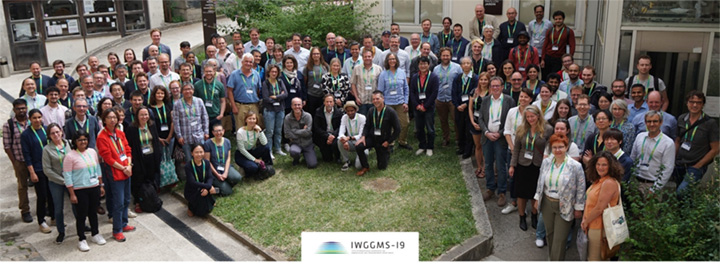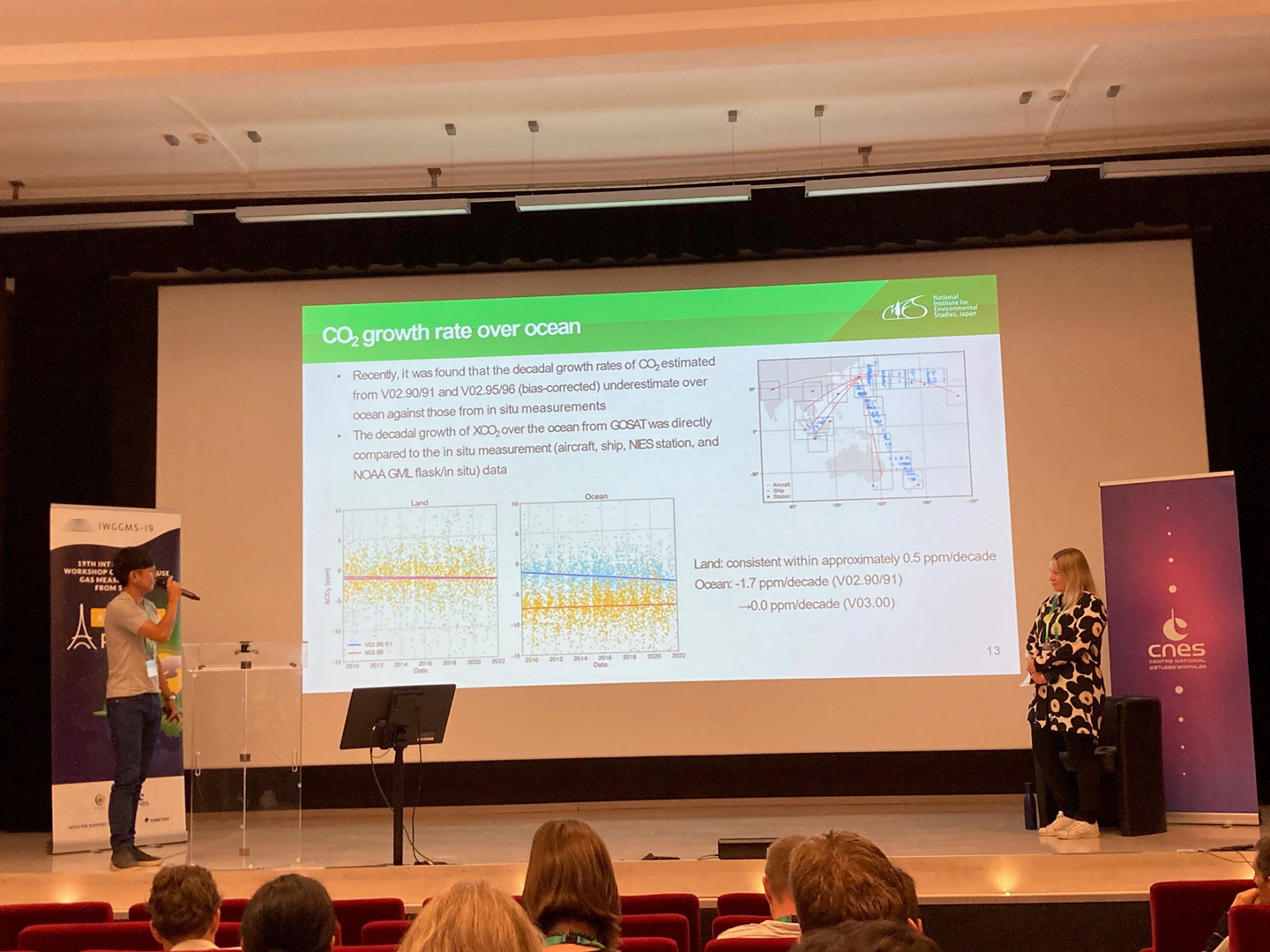Report on the nineteenth International Workshop on Greenhouse Gases Measurement from Space (IWGGMS-19), Paris
The Nineteenth International Workshop on Greenhouse Gases Measurement from Space (IWGGMS-19) was held at the research laboratories of the Ecole Normale Supérieure, Paris, during 4-6 July 2023, jointly hosted by Laboratoire des Sciences du Climat et de l'Environnement (LSCE) and Centre national d'études spatiales (CNES). The workshop was held in a hybrid mode (onsite and online), after a three-year gap due to COVID-19 related restrictions and people were excited to interact in person. There were 68 talks and 86 poster presentations. Here is an overview of the activities during the three days of the meeting with mentions on some key talks.

(https://iwggms19.com/wp-content/uploads/2023/07/Group_Photo5-1280x484.jpg).
Overview
The workshop started with a welcome address by Dr. Francois-Marie Breon, LSCE, and on behalf of Selma Cherchali, CNES, followed by statements from European Space Agency (ESA) and European Organisation for the Exploitation of Meteorological Satellites (EUMETSAT) by Yasjka Meijer and Phi Evans, respectively. The speakers highlighted the importance of IWGGMS as a collective effort which is more vital than before in the era of remote sensing of greenhouse gases. Then the scientific sessions started with the broad topics a) results from current missions, b) status and plans for future missions, c) algorithms, d) calibration and validation, e) emission estimates from local sources, and f) GHG flux estimates. Poster sessions were held vitually every day from 5-7 pm local time.
Scientific sessions
The scientific sessions spanned three days, with a focus on the above topics, with interesting and insightful talks from eminent scientists, followed by questions and discussions.
In the forenoon of the first day about results from Current mission, Akihiko Kuze from Japan Aerospace Exploration Agency (JAXA) presented an overview of the operation and products of GOSAT, GOSAT-2, and GOBLEU (Greenhouse gas Observations of Biospheric and Local Emissions from the Upper sky) aircraft-based observation missions. Junjie Liu from Jet Propulsion Laboratory (JPL), USA, talked about OCO-2 missions focusing on the challenges in CO2 flux quantification. Michael Buchwitz, University of Bremen, Germany, presented some major quality improvements in TROPOspheric Monitoring Instrument (TROPOMI) Weighting Function Modified Differential Optical Absorption Spectroscopy (WFMD) products by revising the Digital Elevation Model (DEM), application of the de-striping algorithm, etc. A comparison of WFMD and the revised operational product was presented, showing reasonably good agreement between the two products. A multi-algorithm merged TROPOMI product in preparation was also mentioned. Tobias Borsdorf explained the near-real-time processing of TROPOMI for operational products. Vivienne Payne reported about OCO-2 Latest version of Lite XCO2 products (v11.1), released in June 2023. Lite products include bias correction (and quality flags), with main improvement in v11.1 Lite relative to v11 Lite relating to the assumed surface elevation (surface pressure), and uses the Copernicus GLO90 DEM, which results in reduced XCO2 biases at high latitudes compared to DEM used in v11. Various presentations reported plume detection using satellite observations such as PRISMA, EnMAP, Sentinel-2, and TROPOMI.
During the afternoon session of the first day on Status and plans for Future missions, David Crisp, Crisp Spectra, the former OCO-2 Science Lead, brought to the attention of the participants on implementing a global monitoring and verification system, emphasizing the need of space-based high-accuracy observing system for observing weaker large-scale sources and sinks. Tsuneo Matsunaga and Hiroshi Tanimoto, NIES, reported the past, present and future of GOSAT series satellites, emphasizing the mission requirement of GOSAT-GW by the Ministry of the Environment, Japan, activities related to emission detection from point sources and expansion of validation networks. Yasjka Meijer gave an overview of Copernicus CO2M missions. Julia Marshall from the University of Heidelberg, Germany, talked about CO2image mission for quantifying localized emissions of CO2 and CH4. Jochen Landgraf from the Netherlands Institute for Space Research (SRON) discussed about the Twin ANthropogenic Greenhouse Gas Observers (TANGO) mission including two satellites TANGO-Carbon and TANGO-Nitro enabling collocated CO2/CH4 and NO2 measurements at a spatial resolution of 180×300 m with a possible launch in 2027. Beata Bukosa from National Institute of Water and Atmospheric Research (NIWA), New Zealand, presented the capability of MethaneSAT to detect and quantify pastoral agricultural emissions and Philippe Bousquet, LSCE, introduced the Methane Remote Sensing Lidar Mission (MERLIN) missions, characteristics, and advancements in the last five years in spectroscopy, L2 algorithm, and validation.
The second day started with presentations on retrieval Algorithms. In this session, Chris O'Dell delivered an invited talk on the fourteen years of satellite XCO2, retrieval methods, and various sources of biases, including aerosols, clouds, albedo, digital elevation map errors, and even the impact of human alteration of surface terrain. Yu Someya, NIES, reported on the update on NIES GOSAT L2 algorithm from v02 to v03 with the main improvements in the treatment of cirrus clouds, degradation model, solar irradiance spectra, and update in gas absorption coefficients. The same day afternoon, Calibration and validation session saw presentations on calibration and validation of TROPOMI, OCO-2/3 using TCCON, COCCON, AirCore profiles etc.

The final day started with a session on Emission estimates from Local sources. Matthäus Kiel, JPL, reported the utility of OCO-3 SAM mode for mapping emissions at sub-regional, urban, local, or facility scales. A new webpage was reported to be introduced to request OCO-3 SAMs over the user’s desired locations. Hiroshi Suto, from JAXA, presented an overview of the GOBLEU observing system based on aircraft measurements on NO2 and SIF as CO2 emissions and removal markers. Portable instruments measure NO2, SIF, and CO2 through the aircraft window without any modification to the aircraft. Ray Nassar from Environment and Climate Change Canada (ECCC), reported facility-scale (relatively large power plants and oil sand processing facilities) CO2 emission quantification using OCO-2 target and OCO-3 SAMs. Another talk with a similar objective to estimate urban CO2 emissions using target and imaging mode satellite observations was by Gregoire Broquet from LSCE, France. Dustin Roten of JPL reported their results on the detection of sector-specific emissions changes from space using OCO-3 over the Los Angeles basin.
The afternoon session of the final day was about GHG flux estimates. Shamil Maksyutov, NIES, talked about the carbon sink estimates with the high-resolution inverse model using ground-based and satellite data. Eva-Marie Metz from the University of Heidelberg, Germany, talked about their recent paper on soil respiration-driven CO2 pulses dominating the flux variability of Australia. Hannah Nesser from Harvard University presented the success of TROPOMI inversion to infer methane emissions contribution from US states, urban regions, and landfills. A comparison inversion of three TROPOMI products (operational product v1.04.00, SRON, and WFMD scientific products) was reported by Antoine Berchet of LSCE, who noted inconsistencies in their results. The scientific session were finished by a talk by the author myself about the country-level sectoral methane emissions, and their decadal trends (2009-2020) estimated by a high-resolution inversion using GOSAT NIES L2 data (v02.95) along with observations from other non-remote sensing platforms.
In the concluding session, the venue for the next meeting IWGGMS-20 was announced by Helen Worden to be held in Colorado, USA. Overall, the participants had very active interaction, especially early career scientists who could share their ideas with and broaden their insight by interacting with the veteran scientists. Throughout the three days of the workshop, the historic venue established centuries ago at the heart of Paris was lively with a warm ambiance, serious discussions, and agreements on future collaboration to efficiently work towards exploring the potential of space-based measurement and monitoring of greenhouse gases, until all meet once again at Colorado in 2024.

